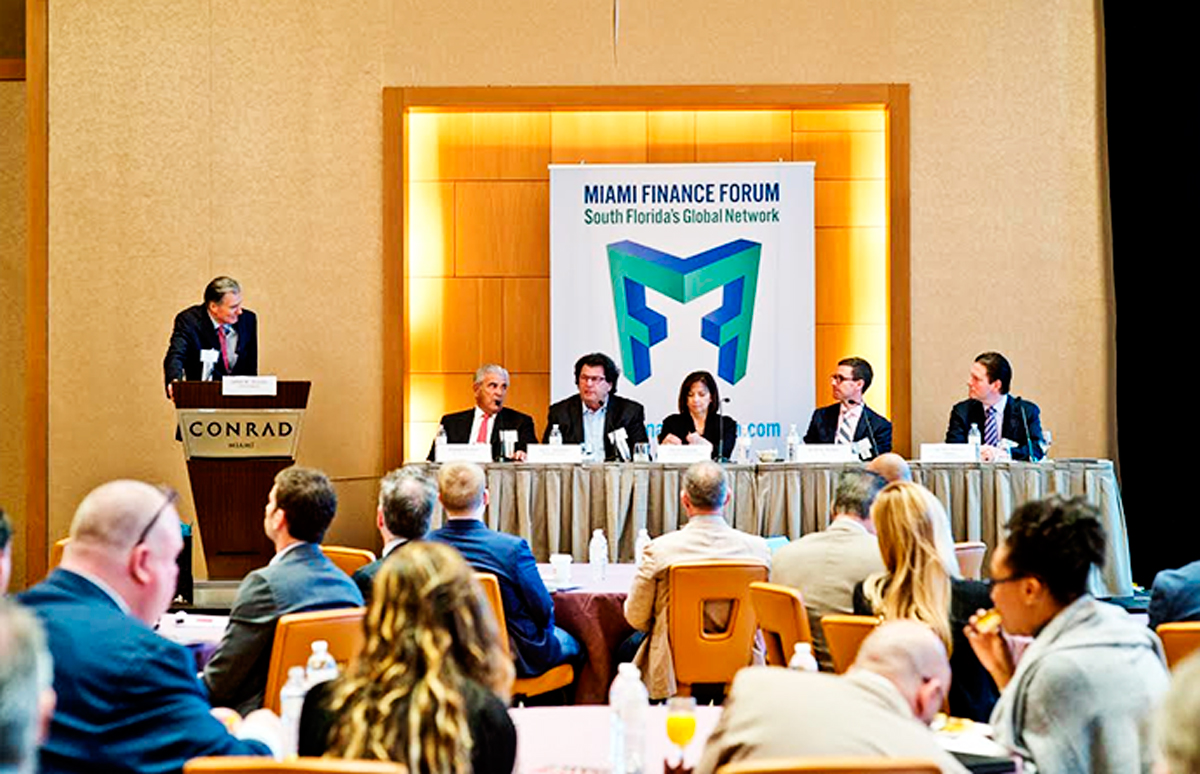Don’t count developer Jay Jacobson among the multifamily developers catching onto the micro unit wave.
“I’m not a big fan of solving affordability issues by cramming people into glorified hotel rooms,” Eden Multifamily’s president said during a Miami Finance Forum event on Friday. “I apologize to anyone in that business or [who] invested in it. If you are, I would look at a different business plan.”
Jacobson, one of South Florida’s leading apartment builders, participated in a panel discussion on the state of the hotel, industrial, multifamily, office and retail markets. Held at the Conrad Miami at 1395 Brickell Avenue in Miami, the panel was moderated by Bilzin Sumberg law firm partner James Shindell and also featured Edward Easton, chairman of the Easton Group; Danet Linares, vice-chairwoman of Blanca Commercial Real Estate; Andrew Dickey, senior vice-president for JLL; and Matthew Whitman Lazenby, president and CEO of Whitman Family Development.
In recent years, the number of apartment projects offering micro units — which are typically less than 500 square feet of living space — has been slowly rising across Miami.
In Wynwood, The Related Group has partnered with Block Capital Group to build Wynwood 26, an apartment complex that will have 176 micro units, and is co-developing Wynwood 25, a mixed-use project that will feature apartments as small as 400 square feet, with East End Capital. Property Markets Group is offering 450-square-foot studios in its Vice rental tower in the Arts and Entertainment District. And in November, the Miami City Commission amended the city’s zoning code to reduce the minimum size of micro units from 400 square feet to 275 square feet.
Yet Jacobson said Miami is not an ideal market for micro units because rent prices have not reached the unattainable heights found in New York City, San Francisco and Seattle. He noted micro unit projects in those cities tend to provide only temporary housing for millennials starting their careers in the tech sector.
“It was successful in Seattle because four buildings [with micro units] are within walking distance of Amazon’s headquarters,” Jacobson said. “The constant turnover in employees justifies that type of housing. I don’t see it working anywhere else.”
Besides, multifamily development is booming in South Florida due to strong population growth and strong demand for rental housing, Jacobson said. “There is an incredible amount of demand in my sector and a tremendous amount of pressure,” he said. “There is unlimited supply of capital, too. Thousands of units are getting built in central Miami with all cash. High net worth investors love apartments because they are long-term income generators.”
Jacobson is not the first apartment developer to cast doubt on the micro unit trend. In November, at a Bisnow event, Melo Group principal Carlos Melo said he doesn’t believe building smaller apartments will make it more affordable for renters. “The cost of land in the city makes the price per unit the same regardless of size,” he said at the time. “So you really don’t reduce the price of the unit.”
The other Miami Finance Forum panelists offered bullish outlooks on the hotel, industrial, office and retail sectors. Easton said the availability for financing and equity for industrial warehouse development has never been as accessible as it is today.
“The industrial market is white hot,” Easton said. “We are 98 percent full and the turnover ratio is about 6 percent because tenants don’t have anywhere to go. There is no space available.”
Linares said office leasing activity is up 12 percent over last year in all of Miami-Dade’s office submarkets. “From 2012 to now, we have seen a jump in rental rates of 25 percent,” Linares said. “Today, rents are averaging $40 a square foot.”
Yet, rising land costs are forcing commercial developers to build mixed-use projects rather than standalone office buildings, Linares said. “We had 500,000 square feet of new office space last year,” she said. “This year, 1.5 million square feet is being delivered.”
Dickey said the hotel industry is just beginning to bounce back after 10 months of stagnation caused by the threats of Zika and hurricanes. “Mother Nature is the biggest disruptor,” Dickey said. “We peaked in 2015. And 2017 was fairly flat.”
Still, there are some signs of a rebound. Revenue per room grew by 2.5 percent in the fourth quarter of 2017, Dickey said. “It could have been flat or negative,” he said.
Lazenby, whose company owns the Bal Harbour Shops, said luxury retail is picking up after three years of slow momentum. “Last year, we turned a corner,” Lazenby said. “This year, so far, we are off to the races.”




